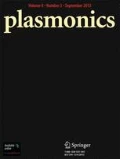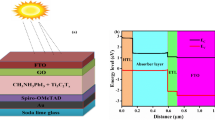Abstract
In the few past years, the economic and eco-friendly Cu2ZnSnS4 (CZTS) solar cells have caught lots of attentions. However, due to rather poor efficiency, identifying deficiencies and making improvements is necessary. In the present study, the performance improvement of ultrathin CZTS solar cells was achieved through (1) incorporation of anti-reflective coating (ARC) on the surface of cell and (2) embedding Al plasmonic nanostructures with different radius, periods, and vertical positions in the absorber layer. Various thicknesses of CZTS absorber layer were simulated optically and electrically using FDTD and DEVICE solver of Lumerical software. The reference solar cell consists of a 1.5-nm-thick CZTS absorber and exhibit an efficiency of up to 5.67%, short-circuit current density (Jsc) of 18.48 mA cm−2 and open circuit voltage of 0.58 V. Result showed a remarkable performance enhancement of the solar cell in spite of a very thin absorber layer. For a 500-μm-thick CZTS solar cell with the assistance of ARC and embedding Al plasmonic nanostructures, the efficiency is increased to 7.45% due to an increase in Jsc to 22.62 mA cm−2 with an open circuit voltage of 0.62 V.






















Similar content being viewed by others
Data Availability
The authors confirm that the data supporting the findings of this study are available from the corresponding author on request.
Code Availability
The authors confirm that the codes used for this study are available from the corresponding author on request.
References
Nakamura M, Yamaguchi K, Kimoto Y, Yasaki Y, Kato T, Sugimoto H (2019) Cd-Free Cu(In, Ga)(Se, S)2 thin-film solar cell with record efficiency of 23.35%. IEEE J Photovoltaics 9:1863–1867. https://doi.org/10.1109/JPHOTOV.2019.2937218
Wesoff E (2016) First Solar Hits Record 22.1% Conversion Efficiency for CdTe Solar Cell. https://www.greentechmedia.com/articles/read/First-Solar-Hits-Record-22.1-Conversion Efficiency-For-CdTe-Solar-Cell
Haddout A, Raidou A, Fahoume M (2019) A review on the numerical modeling of CdS/CZTS-based solar cells. Materials Science and Processing. Appl Phys A. https://doi.org/10.1007/s00339-019-2413-3
Adewoyin A, Olopade M, Oyebola O, Chendo A (2019) Development of CZTGS/CZTS tandem thin film solar cell using SCAPS-1D. Optik 176:132–142. https://doi.org/10.1016/j.ijleo.2018.09.033
Gezgin SY, Kılıc HS (2020) An improvement on the conversion efficiency of Si/CZTS solar cells by LSPR effect of embedded plasmonic Au nanoparticles. Opt Mater 101:109760. https://doi.org/10.1016/j.optmat.2020.109760
Shabat MM, Nassar SA, Schaadty DM (2020) Simulation of three types of nanoparticles on solar cell structure model. Int J Mod Phys B 34:1–10. https://doi.org/10.1142/S021797922050054X
Spinelli P, Polman A (2012) Prospects of near-field plasmonic absorption enhancement in semiconductor materials using embedded Ag nanoparticles. Opt Express 20:A641. https://doi.org/10.1364/oe.20.00a641
Ghahremanirad E, Olyaee S, Hedayati M (2019) The influence of embedded plasmonic nanostructures on the optical absorption of perovskite solar cells. Photonics 6. https://doi.org/10.3390/photonics6020037
Perrakis G, Kakavelakis G, Kenanakis G et al (2019) Efficient and environmental-friendly perovskite solar cells via embedding plasmonic nanoparticles: an optical simulation study on realistic device architecture. Opt Express 27:31144. https://doi.org/10.1364/oe.27.031144
Rajbhandari P, Emrani A, Dhakal T et al (2014) Antireflection coatings designed by the average uniform algorithm for thin film solar cells. Appl Opt 53:34. https://doi.org/10.1364/ao.53.008006
Tunuguntla V, Chen W, Shih P et al (2015) A nontoxic solvent based sol–gel Cu2ZnSnS4 thin film for high efficiency and scalable low-cost photovoltaic cells. J Mater Chem A3:15324. https://doi.org/10.1039/c5ta02833g
Zhao H, Persson C (2011) Optical properties of Cu(In, Ga)Se2 and Cu2ZnSn(S, Se)4. Thin Solid Films 519:7508–7512. https://doi.org/10.1016/j.tsf.2010.12.217
Catchpole K, Polman (2008) Plasmonic solar cells. Opt Express 16:21793. https://doi.org/10.1364/oe.16.021793
Nagel JR (2011) Advanced methods for light trapping in optically thin silicon solar cells. PhD dissertation. Available online: https://www.proquest.com/docview/911792111
Yuan Z, Li X, Jing H (2014) Absorption enhancement of thin-film solar cell with rectangular Ag nanoparticles. J Appl Sci. 14(8):823–827. https://doi.org/10.3923/jas.2014.823.827
Nematpour A, Nikoufard M, Mehragha R (2018) Design and optimization of the plasmonic graphene/InP thin-film solar-cell structure. Laser Phys 28(6):066202. https://doi.org/10.1088/1555-6611/aab462
Nematpour A, Nikoufard M (2018) Plasmonic thin film InP/graphene-based Schottky junction solar cell using nanorods. J Adv Res 10:15–20. https://doi.org/10.1016/j.jare.2018.01.008
Mirzaei M, Hasanzadeh J, Abdolahzadeh Ziabari A (2020) Efficiency enhancement of CZTS solar cells using Al plasmonic nanoparticles: the effect of size and period of nanoparticles. J Electron Mater 49:7168–7178. https://doi.org/10.1007/s11664-020-08524-w
Singh G, Verma S (2018) Optimized size and period of Al nanoparticles for thin film GaAs solar cells. AIP Conf Proc 1953. https://doi.org/10.1063/1.5032745
Author information
Authors and Affiliations
Contributions
Mina Mirzaei: performed the numerical simulations and collected the data. Javad Hasanzadeh: provided the draft of manuscript and figures. Ali Abdolahzadeh Ziabari: comments and discussions and wrote the paper.
Corresponding author
Ethics declarations
Conflict of Interest
The authors declare that they have no competing interests.
Additional information
Publisher’s Note
Springer Nature remains neutral with regard to jurisdictional claims in published maps and institutional affiliations.
Rights and permissions
About this article
Cite this article
Mirzaei, M., Hasanzadeh, J. & Abdolahzadeh Ziabari, A. Significant Efficiency Enhancement in Ultrathin CZTS Solar Cells by Combining Al Plasmonic Nanostructures Array and Antireflective Coatings. Plasmonics 16, 1375–1390 (2021). https://doi.org/10.1007/s11468-021-01379-9
Received:
Accepted:
Published:
Issue Date:
DOI: https://doi.org/10.1007/s11468-021-01379-9




